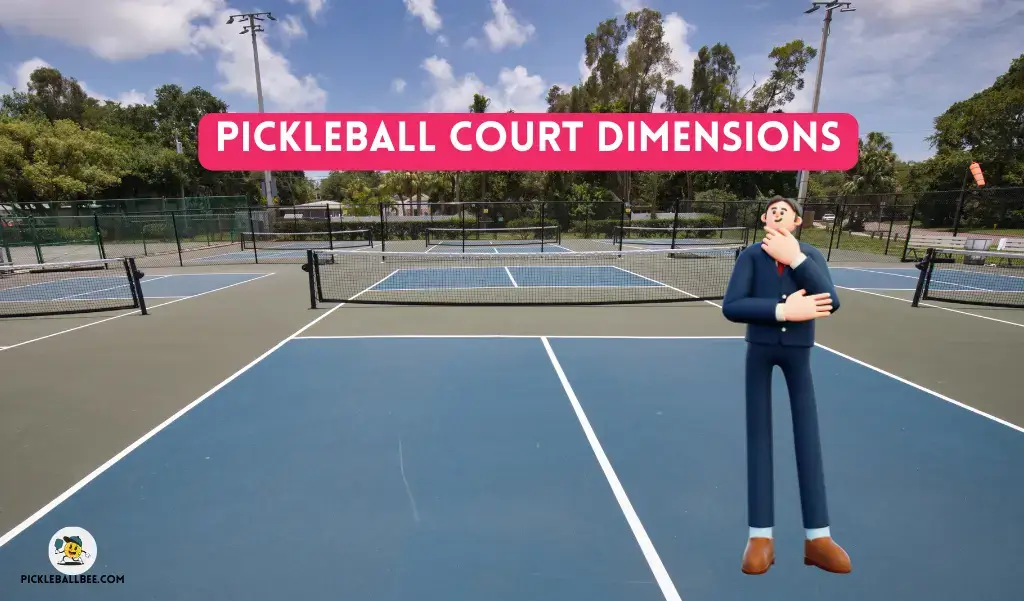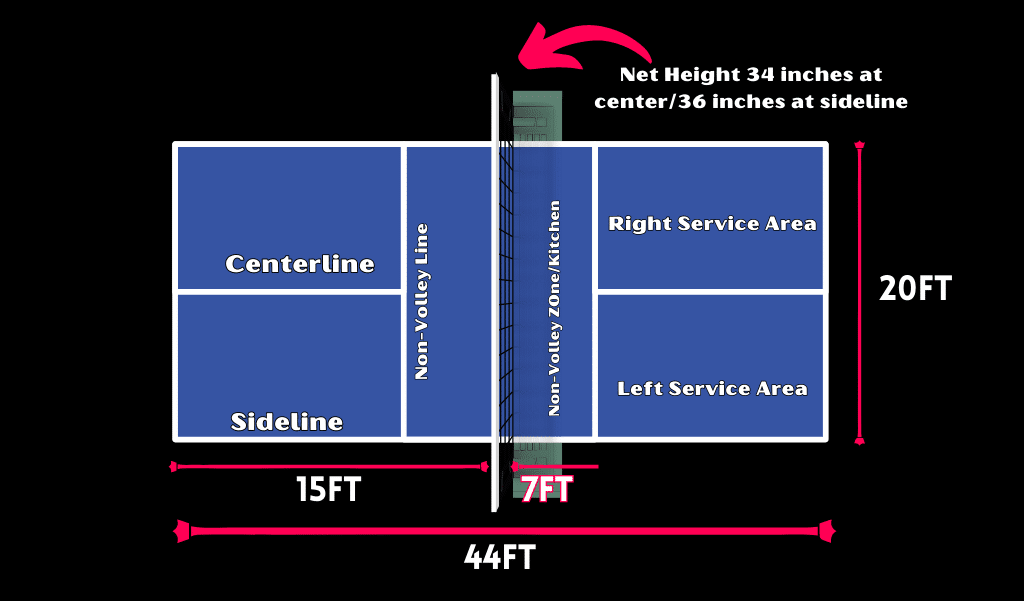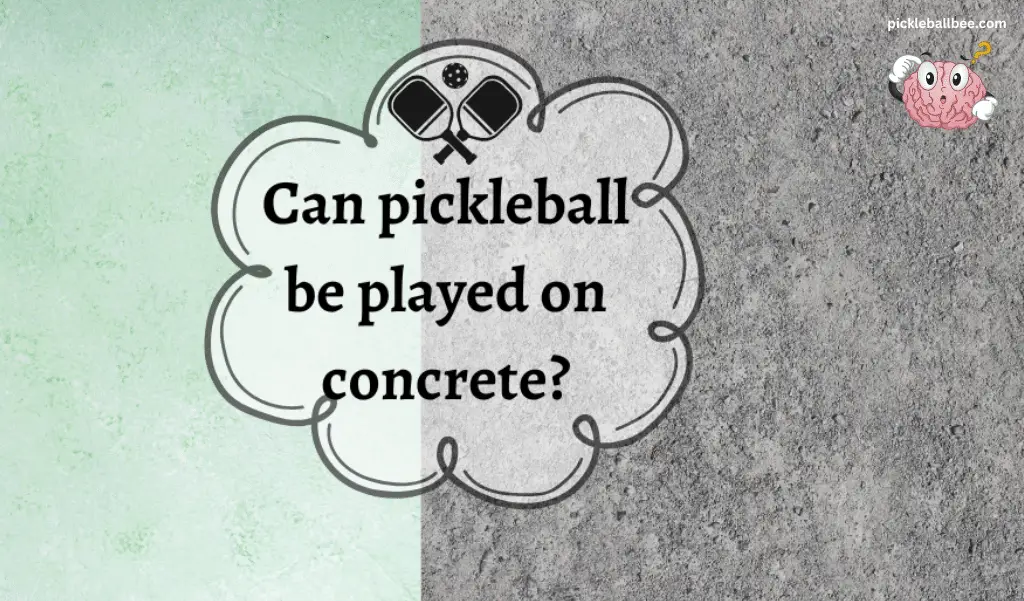Pickleball has become increasingly popular over the past few years, combining elements of tennis, badminton, and table tennis into a fast-paced and fun sport for players of all ages. Understanding the dimensions and layout of a pickleball court is key to proper gameplay and efficient use of space. This guide aims to present a comprehensive understanding of pickleball court size, along with the necessary steps to set up a court correctly.
Getting to Know Pickleball
Before diving into court dimensions, let’s first understand the sport. Pickleball, created in the mid-1960s, uses a perforated plastic ball, often compared to a wiffle ball, and composite paddles, typically smaller than a tennis racquet but larger than a ping-pong paddle. It can be played with two or four players, making it a versatile sport for doubles and singles play.
Pickleball Court Dimension

what are the dimensions of a pickleball court?
“The layout of a pickleball court is similar to a doubles badminton court. The standard court size is 20 feet wide by 44 feet long for both singles and doubles play. This measurement includes the area inside the boundary lines, not including the non-volley zone (also known as the kitchen) and service areas”
The Non-Volley Zone (The Kitchen)
One of the defining features of a pickleball court is the non-volley zone, commonly referred to as “the kitchen.” This is a 7-foot zone on both sides of the net where volleys (hitting the ball before it bounces) are prohibited. The non-volley zone extends to the sidelines and creates a unique dynamic in the game, preventing players from aggressively smashing the ball at the net like in tennis.
The Service Areas
A pickleball court is divided into two service areas or boxes on each side, right and left. Each box measures 15 feet by 10 feet. Serving must be done diagonally, from one service box to the corresponding box on the opposite side. Unlike tennis, there’s no advantage box or deuce box in pickleball.
The Baseline and Sidelines
The court’s outer boundary is marked by the baseline and the sidelines. The baseline runs parallel to the net, 22 feet away on each side. The sidelines are perpendicular to the net and define the width of the court, extending 20 feet from the net on each side.
The Net Dimensions
The net in pickleball plays a crucial role. It’s hung across the middle of the court, dividing it into two equal halves. According to the International Federation of Pickleball (IFP), the net should be 36 inches high at the sidelines and 34 inches in the middle.
Layout of a Pickleball Court
A pickleball court is a rectangle with dimensions of 20 feet wide and 44 feet long, comparable to a doubles badminton court. The court is split into several key areas: service areas, non-volley zones, and a centerline dividing the service areas. Each service area is 15 feet deep and 10 feet wide, and the non-volley zone (the kitchen) extends 7 feet from the net on both sides. The net’s height is 36 inches at the sidelines and 34 inches in the center.
How to Layout a Pickleball Court?
Laying out a pickleball court begins with marking the outer boundaries of the court. You can use chalk or tape for this purpose, measuring out a 20×44 feet rectangle. The next step is setting up the net across the middle of the court, ensuring it’s 36 inches high at the sidelines and 34 inches at the center. Following this, mark out the 7-foot non-volley zone (the kitchen) from the net on both sides of the court. The remaining area is then split into two equal rectangles to form the service areas on both sides.
Space Requirement for Playing Pickleball
While the court itself is 20×44 feet, you’ll need additional space for players to move around. The recommended total playing area is 30×60 feet, allowing for a safe overrun area. This extra space helps players make full swings and run-down balls that are played near the boundaries without fear of colliding with spectators, fences, or other obstacles.
Minimum Size of Pickleball Court
The minimum size for a pickleball court is 20×44 feet, the playing area’s dimensions. However, when considering the minimum size, it’s also important to think about the additional space needed for player movement. If you’re limited on space, the absolute minimum total area could be somewhat smaller than the recommended 30×60 feet, but player safety and gameplay may be compromised.
Key Facts – Pickleball Court Size & Dimensions

Here are the key facts about pickleball court size and dimensions:
1. Court Size: A standard pickleball court is a rectangle with dimensions of 20 feet wide by 44 feet long.
2. Serving Areas: The court is divided into two serving areas – left and right – by a centerline. Each serving area is 10 feet wide and extends from the baseline to the non-volley zone.
3. Non-Volley Zone: Also known as the “kitchen,” the non-volley zone is a 7-foot area adjacent to the net on both sides, extending across the width of the court. No volleying (hitting the ball before it bounces) is permitted within this zone.
4. Net Height: The net height is 36 inches at the sidelines and drops to 34 inches in the center.
5. Surrounding Space: While not part of the court itself, it’s recommended to have at least 10 feet of space behind each baseline and 5 feet on each side beyond the sidelines for player movement and safety.
6. Baseline and Sidelines: These mark the outer boundaries of the court. The baseline is the line farthest from the net while the sidelines are the lines to the left and right of the court.
7. Service Courts: After the serve, points can be scored in either the left or right service court, which are the areas behind the non-volley zones and between the baseline and the non-volley line.
Pickleball Court Lines and Playing Areas
A pickleball court has meticulously defined lines. Baselines run along the court’s ends, parallel to the net, while sidelines define the width. The court is bisected into two service courts per side: right and left, each measuring 15×10 feet. A centerline helps distinguish these service boxes.
Unique to pickleball is a 7-foot area, the non-volley zone or “kitchen”. Players cannot volley (hit before a bounce) in this zone. The non-volley zone extends to the sidelines and is marked by the net and non-volley line.
The playing area incorporates the service courts and non-volley zone, with an overrun area around the court for free movement. These lines guide gameplay and determine legal moves.
How To Set Up A Pickleball Court?
Setting up a pickleball court involves several steps. Following these instructions will ensure your court meets standard dimensions and rules:
- Mark the Outer Boundaries: Use a long measuring tape to measure out a 20×44 feet rectangle. This measurement should be from baseline to baseline and sideline to sideline. Mark these boundaries with chalk or paint.
- Set Up the Net: Position the net across the middle of the court. The net should be installed so it’s 36 inches high at the sidelines and 34 inches at the center. Sturdy posts are needed to support the net, and these posts are typically placed outside the sidelines.
- Define the Non-Volley Zone: Mark out the 7-foot non-volley zone, commonly referred to as “the kitchen,” from the net on both sides of the court.
- Mark the Service Areas: Divide the remaining space on each side into two equal rectangles, each 15 feet deep and 10 feet wide. This will create the right and left service boxes on each side.
- Mark the Centerline: Draw a line between the two service boxes on each side of the court. This line helps distinguish the serving boxes.
- Finalize the Court: Once all lines are drawn, walk around the court to ensure everything is visible and clear. If you’re using paint, allow it to dry fully before starting to play.
- Create a Buffer Zone: Ensure there’s enough space around the court for players to move freely. The recommended extra space is at least 10 feet from the baselines and 5 feet from the sidelines.
- Prepare Equipment: Gather your pickleball paddles and balls, and you’re ready to play!
- Regular Maintenance: Keep the court clean from debris, and dry before each game. Repaint the lines as necessary to keep them clear and visible.
Supplies For Creating A Pickleball Court
Creating a pickleball court requires a range of supplies and equipment. Here’s a list to help you gather everything you need:
1. Measuring Tape: One long tape (at least 50 feet) for accurate measurements.
2. Line Marking Paint or Chalk: A few cans of line marking paint or a couple of boxes of chalk, depending on the permanency of your court.
3. Pickleball Net: One net that meets the correct specifications (34 inches high in the center and 36 inches high at the sides).
4. Pickleball Net Posts: Two sturdy posts to support the net.
5. Pickleball Paddles and Balls: The number varies based on players. At least two paddles and several balls for singles play, and at least four paddles and several balls for doubles play.
6. Court Surface Material: The amount will depend on the court’s size and type. For an outdoor asphalt or concrete court, consult with a professional for the right quantity.
Remember that the quality of your supplies can significantly impact the quality of your court. It’s worthwhile investing in durable, high-quality equipment that will stand up to regular use.
How much space do you need around a pickleball court?
When planning for a pickleball court, it’s not just the court size that you need to take into consideration, but also the additional space around the court. This extra area, often referred to as the ‘overrun’ area, is important for players to move freely, complete full swings, chase down shots, and avoid collision with spectators or obstacles.
The standard pickleball dimensions itself are 20 feet wide by 44 feet long, the size of a doubles badminton court. However, beyond this playing area, the recommended additional space for a comfortable and safe playing environment extends the total area to 30 feet by 60 feet. This means a 10-foot buffer zone behind each baseline and a 5-foot buffer on each side of the court, beyond the sidelines.
This recommended additional space isn’t arbitrarily decided but is based on the dynamics of the game. Given the quick pace of pickleball, players often find themselves running or stepping outside the court’s formal boundaries during an intense rally.
However, space availability might not always allow for this ideal scenario. In such cases, the extra space can be minimized but should never be eliminated completely. It’s important to note that reducing this space could negatively affect player safety and the quality of gameplay. For instance, if the court is too close to a wall or fence, it can restrict player movement and possibly lead to injuries.
For multi-court setups, it’s recommended to have a minimum of 10 feet between the sidelines of adjacent courts and 12 feet from baseline to baseline.
Conclusion:
In conclusion, Understanding the dimensions and layout of a pickleball court is crucial for gameplay, safety, and space efficiency. The court measures 20 feet by 44 feet, with key zones like the service areas and the “kitchen” or non-volley zone. When establishing a court, it’s vital to account for extra space around it for safety, making the total recommended area 30 feet by 60 feet.
Limited space might necessitate a smaller playing area but could risk player safety and gameplay quality. Setting up a court involves careful measurements, marking, net setup, and upkeep, requiring specific tools and supplies. This guide aimed to provide a comprehensive understanding of pickleball court dimensions and setup, serving as a resource for your pickleball journey. Whether you’re a beginner or an experienced player setting up a court, these guidelines should aid in creating an enjoyable environment for this increasingly popular sport.
FAQs:
-
What is the “kitchen” in pickleball?
The “kitchen” in pickleball is a colloquial term for the non-volley zone. This is a 7-foot area extending from the net on both sides of the court. In this zone, players cannot volley the ball, meaning they cannot hit it in the air before it bounces. Players are allowed to enter the kitchen only if the ball has bounced in this area. Violation of these rules results in a fault. The “kitchen” rule adds a layer of strategic depth to the game of pickleball.
-
How much space is needed around a pickleball court?
Ideally, an additional 10 feet around the pickleball court is needed, making the total recommended area 30 feet by 60 feet.
-
Is the layout of a pickleball court similar to any other sport?
Yes, the layout of a pickleball court closely resembles that of a doubles badminton court. They share similar dimensions and have distinct service and non-volley zones.
-
Can you play pickleball on concrete?
Yes, you can play pickleball on concrete. It’s a popular choice for outdoor courts due to its durability, though it’s harder on the body than softer surfaces.


